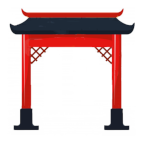|
|
儿
|
 |
|
JLPT HSK 1 |
|
| fragment, child
ér, er
兒
儿
 |
|
This character consists simplified of the radical for: "legs" Traditionally it was: 兒
Two separated legs as fragments or child.

|
|
|
|
觉
|
 |
|
JLPT HSK 1 |
|
| a sleep, a nap, feel, find that, awake, aware
jiào, jué
冖
見
儿
 |
|
From top: light rays  , cover: 冖, to see 见/見 (= an eye 目 on legs 儿) , cover: 冖, to see 见/見 (= an eye 目 on legs 儿)
When the sunshine falls through the cover on your seeing eyes you awake: from sleep.

|
|
|
|
完
|
 |
|
JLPT HSK 2 |
|
| complete, to finish, whole, entire
|
Top: roof 宀, bottom: origin, chin. Yuan 元 (two 二 legs 儿)
(A building is complete when it has a roof. Thus:) A roof needs an origin (= groundwork, seating) to be finished and complete.

|
|
|
|
境
|
 |
|
JLPT HSK 3 |
|
| border, boundary, place, circumstances
|
Left: earth 土, right: actually 竟 (standing 立, sun 日 and legs 儿)
The earth remains standing, while the sun continues to go: We are at the border.

|
|
|
|
元
|
 |
|
JLPT HSK 3 |
|
| Yuan, Chinese monetary unit, primary, first
|
Shows two 二 legs 儿, perhaps as they move like the circulation of the Yuan?

|
|
|
|
克
|
 |
|
JLPT HSK 4 |
|
| to subdue, to overthrow, gram
|
Top: ten 十, below: older brother 兄 (A big mouth 口 on feet 儿)
(The inferior must leave the battle-field, such as to run away using the legs:) The old 古 gets legs 儿, if it is subdued.

|
|
|
|
免
|
 |
|
JLPT HSK 4 |
|
| to avoid, to escape, to excuse sb, to avert
|
An escaping rabbit 兔: long ear ⺈, big eyes 罒, legs 儿 but without tail 丶(a rabbit on the run)
With a big ear, goggle-eyes and two long legs you can escape.

|
|
|
|
无
|
 |
|
JLPT HSK 4 |
|
| -less, not to have, no, none, to lack, un-
|
Composed of two 二 (here as: crossed out) and legs 儿
Legs crossed out twice as: negative.

|
|
|
|
光
|
 |
|
JLPT HSK 4 |
|
| light, ray, bright, merely, to use up
|
Combination of fire 火 and legs 儿. The legs stand for transportability of the fire (i.e. in a lantern)
The fire which can be transported stands for light.

|
|
|
|
虎
|
 |
|
JLPT HSK 4 |
|
| tiger
|
Top: tiger 虍 (pictograph: jumping tiger with protruding teeth), below: hind legs 儿
Only a tiger on hind legs is a real tiger.

|
|
|
|
允
|
 |
|
JLPT HSK 4 |
|
| to permit, to allow, grant, fair
|
Top: nose 厶, below: legs 儿
Who has a nose and legs shall be permitted.

|
|
|
|
竟
|
 |
|
JLPT HSK 4 |
|
| actually, unexpectedly, indeed
|
Top: sound 音 (Stand/Get up 立 into the day 日 with sounds [of the alarm clock]), bottom: legs 儿
(My knee is cracking!) Sounds in the legs? Actually?

|
|
|
|
充
|
 |
|
JLPT HSK 5 |
|
| satisfy, fulfill, substitute
chōng
儿
 |
|
Top: newborn baby  (child 子 turned upside down, because at birth with head first), below: legs 儿 - Here: see similarity to flow/stream 流 (child 子 turned upside down, because at birth with head first), below: legs 儿 - Here: see similarity to flow/stream 流
The new born baby flounders with his legs to be 'filled' [= fed] and thus be satisfied.

|
|
|
|
统
|
 |
|
JLPT HSK 5 |
|
| context, to gather, to unite, whole
|
Left: thread 纟/糸, right: satisfy, to fill 充 (The newborn baby  [= child 子 upside down, because it comes with the head first] flounders with his legs 儿 to be 'filled' [= fed] and thus be satisfied. (cf.流) [= child 子 upside down, because it comes with the head first] flounders with his legs 儿 to be 'filled' [= fed] and thus be satisfied. (cf.流)
Threads are satisfying if they are in a context. (i.e. woven)

|
|
|
|
兄
|
 |
|
JLPT HSK 5 |
|
| elder brother
|
A mouth 口 and feet 儿
A "big mouth on legs" is my older brother.

|
|
|
|
兔
|
 |
|
JLPT HSK 5 |
|
| rabbit
|
avoid/escape 免 (an escaping rabbit 兔: long ears ⺈, big eyes 罒, legs 儿) and further short tail 丶
It can 'escape' and has a short tail: The rabbit.

|
|
|
|
兆
|
 |
|
JLPT HSK 6 |
|
| omen, to foretell, trillion (10^12), tera-
|
Pictograph: cracks in a turtle shell (was used in ancient China for divination)
The cracked turtle shell shows a trillion signs.

|
|
|
|
兜
|
 |
|
JLPT HSK 6 |
|
| bag, pocket, to take responsibility
|
Inside: white 白, outside: handles  コ, and legs 儿 (or tassels ..) コ, and legs 儿 (or tassels ..)
A white bag with handles and tassels.

|
|
|
|
党
|
 |
|
JLPT HSK 6 |
|
| political party, association, society
|
Top: still/esteem 尚 (A small 小 house 宀 with a window 口 is furthermore esteemed.), below: legs 儿 (or: elder brother 兄 = A big mouth 口 on feet 儿)
I have esteem for my elder brother's party.

|
|
|
|
兢
|
 |
|
JLPT HSK 6 |
|
| apprehensive, to be fearful, tremble
|
Twice: subdue 克 (The old 古 gets legs 儿, when it is subdued)
Being doubly subdued is apprehensive.

|
|
|
|
彪
|
 |
|
JLPT no HSK |
|
| (tiger)-stripes, a tiger-cat, streaks, veins
|
Left: tiger 虎 (= tiger 虍 on the hind legs 儿), right: hair 彡
The tiger's hair have stripes.

|
|
|
|
兀
|
 |
|
JLPT no HSK |
|
| rising to a height, towering, bald
|
Up to the measuring line 一 are his legs 儿, that's how high he is risen.

|
|
|
|
倪
|
 |
|
JLPT no HSK |
|
| feeble, tiny, young and weak
|
Left: person 亻, right: fragment, child 兒/儿 (simplified to 儿, with mortar 臼 and legs 儿)
The person, who is like a 'child' is: feeble.

|
|
|
|
霓
|
 |
|
JLPT no HSK |
|
| secondary rainbow
|
Top: rain 雨, bottom: fragment, child 兒/儿 (typically simplified to 儿, as a mortar 臼 and legs 儿)
At rain the rainbow 虹 has a child: the secondary.

|
|

